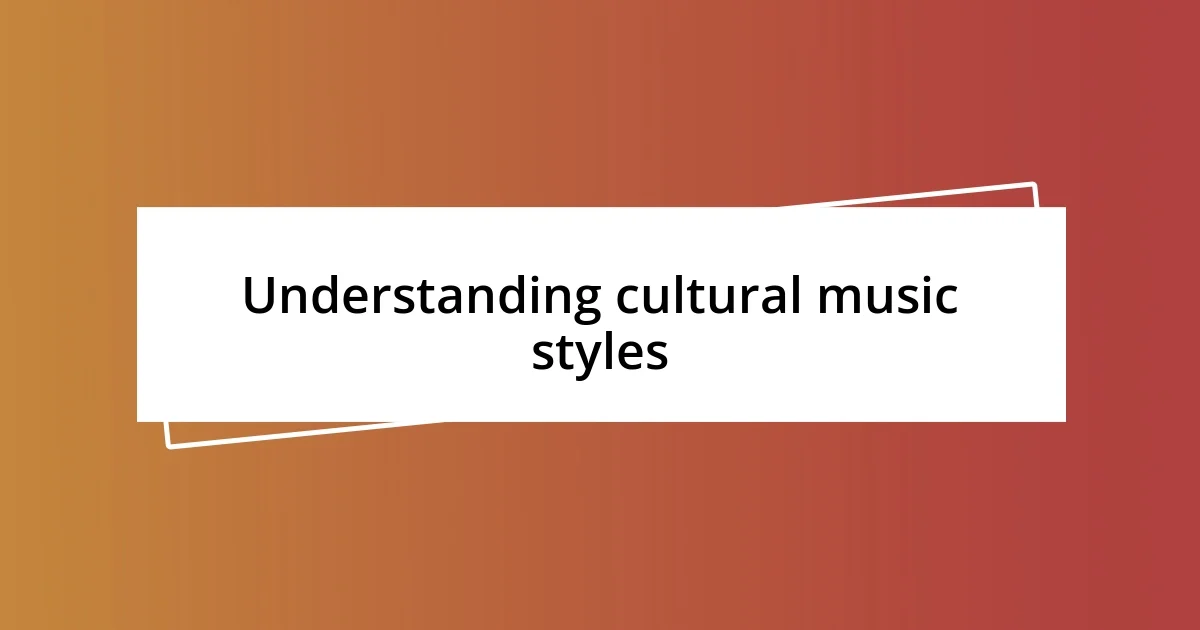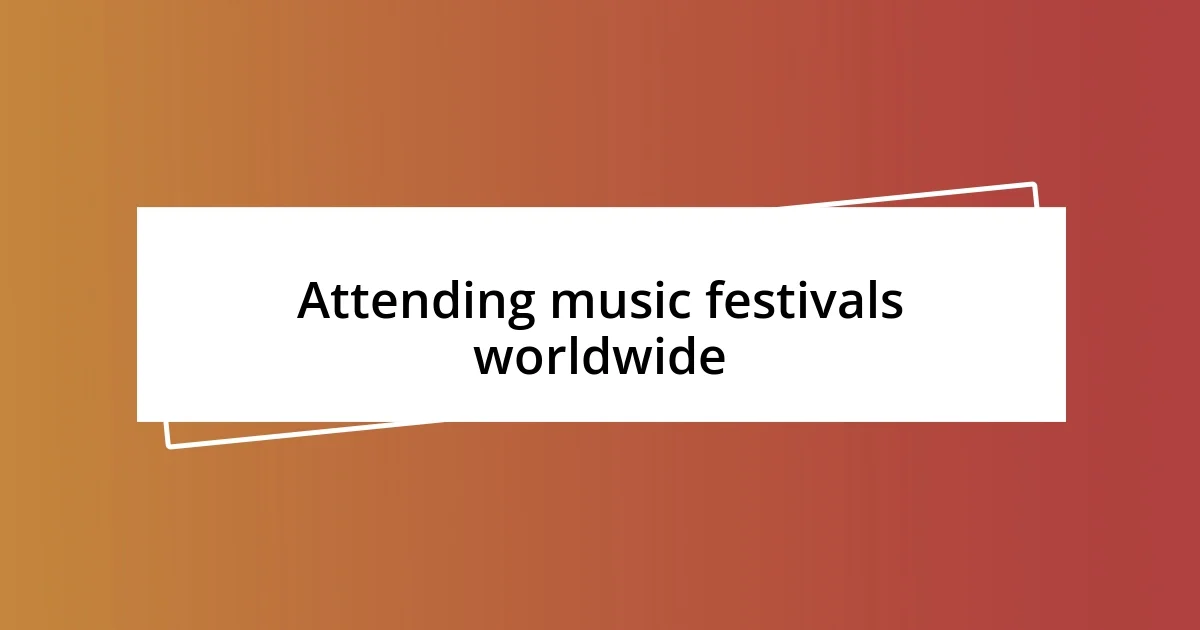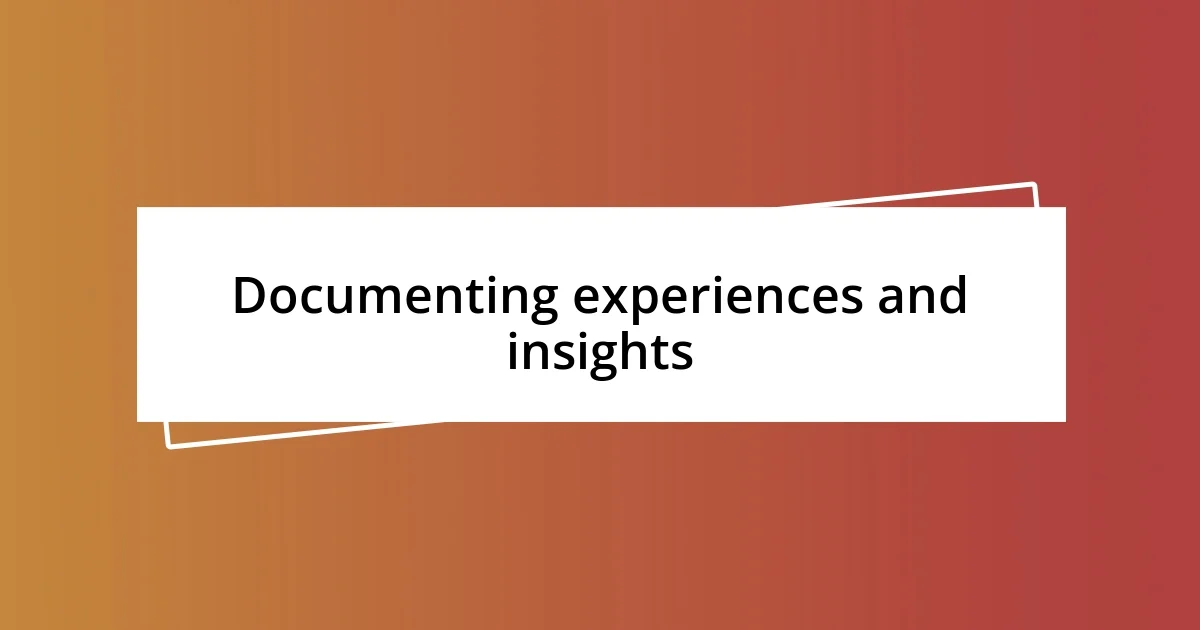Key takeaways:
- Cultural music styles express community histories and emotions, fostering connections across diverse backgrounds.
- Engaging with local musicians enhances understanding and appreciation of music, revealing the stories behind melodies.
- Documenting and sharing musical experiences through storytelling enriches personal insights and encourages cultural exploration.

Understanding cultural music styles
Cultural music styles are like windows into the soul of a community. I remember the first time I listened to traditional Gamelan music from Indonesia; the intricate rhythms and vibrant melodies pulled me in instantly. It made me wonder: how does a culture’s history and values shape its sound?
I often find that each cultural music style tells a story, reflecting the experiences and emotions of its people. For example, when I heard the heart-wrenching notes of a Flamenco guitar, I could almost feel the passion and pain that spilled out with every strum. Isn’t it fascinating how music can evoke such powerful feelings, even if we don’t fully understand the words?
Exploring various cultural music styles has deepened my appreciation for diversity. I can still feel the energy of a lively African drum circle I once joined. The sense of community was electric, and in that moment, I realized that music is a universal language that transcends barriers, inviting us to connect in ways we never expected.

Exploring personal music preferences
I have always found my personal music preferences to be a little unpredictable. Sometimes, I’m drawn to the haunting melodies of Celtic folk music, which remind me of cozy nights by the fire while listening to stories of mythical adventures. Other times, I crave the upbeat rhythms of Caribbean steel drums, instantly transporting me to sunlit beaches. These shifts in preference make me ponder how mood and setting can influence what I enjoy listening to at any given moment.
It’s interesting to reflect on how our backgrounds shape our musical tastes. Growing up, my family often played jazz at home, with the smooth sounds of saxophones filling the air. This exposure cultivated a love for improvisation in music, something that truly resonates with me now. I can see how family traditions and experiences have a lasting impact on the types of music I am drawn to, much like how a painter’s palette is influenced by the colors they grew up seeing.
I’ve also found that discovering new music often comes from shared experiences with friends. For instance, attending a local world music festival opened my ears to Balkan brass bands. The exhilarating hours spent dancing and laughing with strangers brought me a profound sense of joy. This experience taught me that exploring personal music preferences often leads to unforgettable moments that enrich our lives.
| Music Style | Personal Connection |
|---|---|
| Celtic Folk | Cozy nights, storytelling |
| Caribbean Steel Drums | Transport to sunlit beaches |
| Jazz | Family tradition, improvisation |
| Balkan Brass | Dancing at festivals, joy with friends |

Researching cultural music origins
Researching the origins of cultural music can immerse you in a world rich with history and emotion. I remember digging into the roots of Brazilian Samba and discovering its connections to African traditions and Brazilian African slaves. This exploration wasn’t just academic; I could almost hear the echoes of their struggles and joys in the lively beats. Each time I uncover the story behind a musical style, it feels like connecting with the heartbeat of an entire culture.
Here’s a quick snapshot of the key aspects I focus on when researching cultural music origins:
- Historical Context: Understanding the events that shaped the culture.
- Cultural Influences: Identifying how different communities have interacted over time.
- Instruments: Learning about traditional instruments and their significance.
- Rhythms and Melodies: Analyzing unique patterns and how they express cultural identity.
- Personal Stories: Engaging with local musicians to hear their perspectives.
When I explored the roots of Native American music through conversations with elders, I felt deeply moved. They shared how their melodies encapsulate stories of nature and spirituality, a tradition passed down through generations. This firsthand insight made the music come alive in ways books couldn’t capture. Each note seemed to resonate with the essence of their life experiences, creating a profound connection that continues to inspire me.

Connecting with local musicians
Engaging with local musicians has been one of the most rewarding parts of my musical journey. I remember attending a small pub gig where a group of Irish musicians played traditional songs. It was fascinating to see how their faces lit up as they shared stories behind each tune. Have you ever felt that electric connection when music becomes a shared language? I certainly did that night, realizing how personal experiences can transform a simple performance into a celebration of culture.
Participating in jam sessions has helped me forge genuine connections with local artists. One memorable evening, I joined a circle of musicians in a bustling market square, and we spontaneously created a blend of sounds – a fusion of my guitar with their traditional flutes and drums. The experience was exhilarating! It made me appreciate how collaboration can give birth to new musical styles, weaving together different cultural elements in an unexpected symphony. Isn’t it incredible how sharing your musical talents can lead to forging friendships?
I’ve also discovered that simply asking questions can open up a world of insights. I once spent an afternoon with a local folk singer, who generously taught me about the stories behind his songs. His tales of love, loss, and community left a mark on my heart. I often wonder: how often do we pause to listen to the narratives that shape the music we love? This intimate exchange reminded me that connecting with local musicians goes beyond just understanding the music; it also deepens our appreciation for the life experiences that inspire each note.

Attending music festivals worldwide
Attending music festivals around the globe has opened my eyes to a kaleidoscope of cultural expressions. I remember stepping into a vibrant gathering in Bali, where the scent of incense wafted through the air as local musicians played traditional gamelan. The sense of community was overwhelming; I felt like I was part of something profound. Have you ever been in a space where the music wrapped around you like a warm embrace? That moment made me realize how festivals can serve as a bridge between diverse cultures, creating shared experiences.
In another instance, at a folk music festival in the hills of Appalachia, I encountered a group of elders sharing their rich musical heritage. Their performances radiated joy, telling stories from their youth, and I found myself dancing along, caught up in the rhythm. I often ponder how these gatherings not only preserve musical traditions but also foster connections across generations. Doesn’t it amaze you how music can transcend language barriers, uniting people with different backgrounds? That night, surrounding by laughter and song, I felt a tight bond with strangers, all united in our love for the music echoing through the hills.
I believe that music festivals are not just about the performances; they’re also a celebration of cultural identity. At a festival in Mexico, surrounded by bright papel picado and the sounds of mariachi bands, I experienced a deep sense of belonging. The vibrant culture pulsated through every note played, reminding me that music is a living, breathing reflection of who we are. I recall exchanging smiles with locals and fellow festival-goers, as if we were all in on a beautiful secret. Have you ever found a piece of yourself in the music of a different culture? For me, these festivals are journeys of discovery, weaving together stories and emotions that resonate long after the music fades.

Documenting experiences and insights
Documenting experiences and insights from my musical journey has been an enriching process. I remember sitting down with my notebook after an evening spent with a mariachi band. I jotted down not just the melodies I heard, but the laughter, the energy in the air, and the passion that flowed through each performance. Have you ever tried to capture a moment, only to realize how much more it is than just notes on a page? That night, the page filled with emotions, memories, and the vibrant spirit of the musicians enveloped me.
Reflecting on these experiences has helped me connect the dots in understanding different musical styles. After attending a traditional south Indian Karnatic music concert, I was captivated by the intricate rhythms and improvisational aspects of the performance. While I initially struggled to grasp the complexity, discussing it later with a local musician transformed my confusion into admiration. Do you find that reflecting on your own misunderstandings can lead to deeper insights? For me, the journey of documenting these nuances has not only enhanced my appreciation for the music but also for the diverse cultures behind it.
Writing about these moments allows me to relive them, almost as though I’m sharing a cup of tea with friends. I recall a delightful afternoon spent with a group of musicians in a small village, where we engaged in storytelling through music. As we strummed our guitars and tapped our feet, I realized how music is a universal language that conveys emotions words often fail to express. Have you ever noticed how a particular song can evoke memories you thought you’d forgotten? By documenting these moments, I find threads of connection woven through different cultures, reminding me that despite our differences, the heart of music beats in unison worldwide.

Sharing findings through storytelling
Sharing my findings through storytelling has become a deeply rewarding part of my journey. Recently, while chatting with a friend after a concert featuring African drumming, I found myself recounting the story behind every beat. I shared how those rhythms echoed the heartbeat of a community, capable of narrating a history that spans generations. Have you ever found a piece of your story resonating with someone else’s experience? In that moment, our discussions transformed into an exploration of cultural narratives, showing me that storytelling is a way to honor and amplify these musical legacies.
I once stumbled upon an intimate gathering in a small pub in Ireland where musicians spontaneously joined together to share traditional tunes. As the night unfolded, I realized how each note carried fragments of personal stories and collective memories. The laughter and the clinking of glasses intertwined with heartfelt melodies, creating a tapestry of culture. It made me wonder: isn’t it fascinating how storytelling weaves connections that transcend geographical boundaries? Sharing this experience not only enriched my understanding but also invited others into the warmth of that cozy space, encapsulating the essence of what musical storytelling can achieve.
As I reflect on these moments, I see how storytelling fuels curiosity and a desire for deeper connection. After a visit to a North African festival, I immersed myself in the intricate tales told through the music, each carried by lively dancers. I vividly recall a dancer spinning and inviting audience members to join, blurring lines between performers and spectators. This interaction made me think: how often do we miss opportunities to engage with cultures that aren’t our own? By sharing these experiences, I hope to inspire others to seek out their own adventures, reminding us that each story adds to the rich tapestry of our shared human experience.














